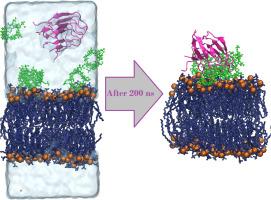对羟丙基-beta-环糊精(HPBCD)在阿尔茨海默病中与细胞膜附近的淀粉样β(Aβ)斑块相互作用的抑制功能进行分子动力学研究。
IF 3.8
Q2 CHEMISTRY, PHYSICAL
引用次数: 0
摘要
虽然阿尔茨海默病早已为人所知,但有趣的是,科学家们仍在对它进行广泛的研究。同时,在实验研究的同时,计算研究也取得了有趣的成果。在本研究中,我们利用分子动力学模拟研究了羟丙基-β-环糊精(HPBCD)候选药物的抑制行为,这些候选药物比β-环糊精(BCD)更易溶,并与 AC0107 新药进行了比较。研究关注的参数包括细胞膜稳定性、蛋白质稳定性、药物抑制率、蛋白质渗透性、氢键剂、不同基团间相互作用的能量含量研究以及不同物种间的相互作用。结果表明,候选药物 HPBCD 具有抑制蛋白质膜渗透的作用,其性能优于 AC0107 新药。换句话说,HPBCD 不仅可以作为阿尔茨海默病的药物载体,还可以作为阿尔茨海默病的抑制剂,对改善阿尔茨海默病起到双重作用。本文章由计算机程序翻译,如有差异,请以英文原文为准。

A molecular dynamics investigation into the inhibitory function of hydroxypropyl-beta-cyclodextrin (HPBCD) in its interaction with amyloid-beta (Aβ) plaques near the cell membrane in the context of Alzheimer's disease.
Although Alzheimer`s disease has been known for a long time, it is interesting that scientists are still doing widespread research on it. Meanwhile, in parallel with experimental research, computational research is also yielding interesting results. In this study, we investigated the inhibitory behavior of hydroxypropyl-beta-cyclodextrin (HPBCD) drug candidates, which are more soluble than beta-cyclodextrin (BCD), using molecular dynamics simulations and compared them with AC0107 new drug. Parameters such as cell membrane stability, protein stability, drug inhibition rate, protein permeability, hydrogen bonding agents, the study of the energy content of interactions between different groups, and interactions between different species were of interest. The outcomes indicate that the drug candidate HPBCD has a role in inhibiting protein membrane penetration and has better performance than new AC0107 drug. In other words, HPBCD not only act as a drug carrier of Alzheimer's disease, but also as an inhibitor of it and can play a double role in its improvement.
求助全文
通过发布文献求助,成功后即可免费获取论文全文。
去求助
来源期刊

Chemical Physics Impact
Materials Science-Materials Science (miscellaneous)
CiteScore
2.60
自引率
0.00%
发文量
65
审稿时长
46 days
 求助内容:
求助内容: 应助结果提醒方式:
应助结果提醒方式:


